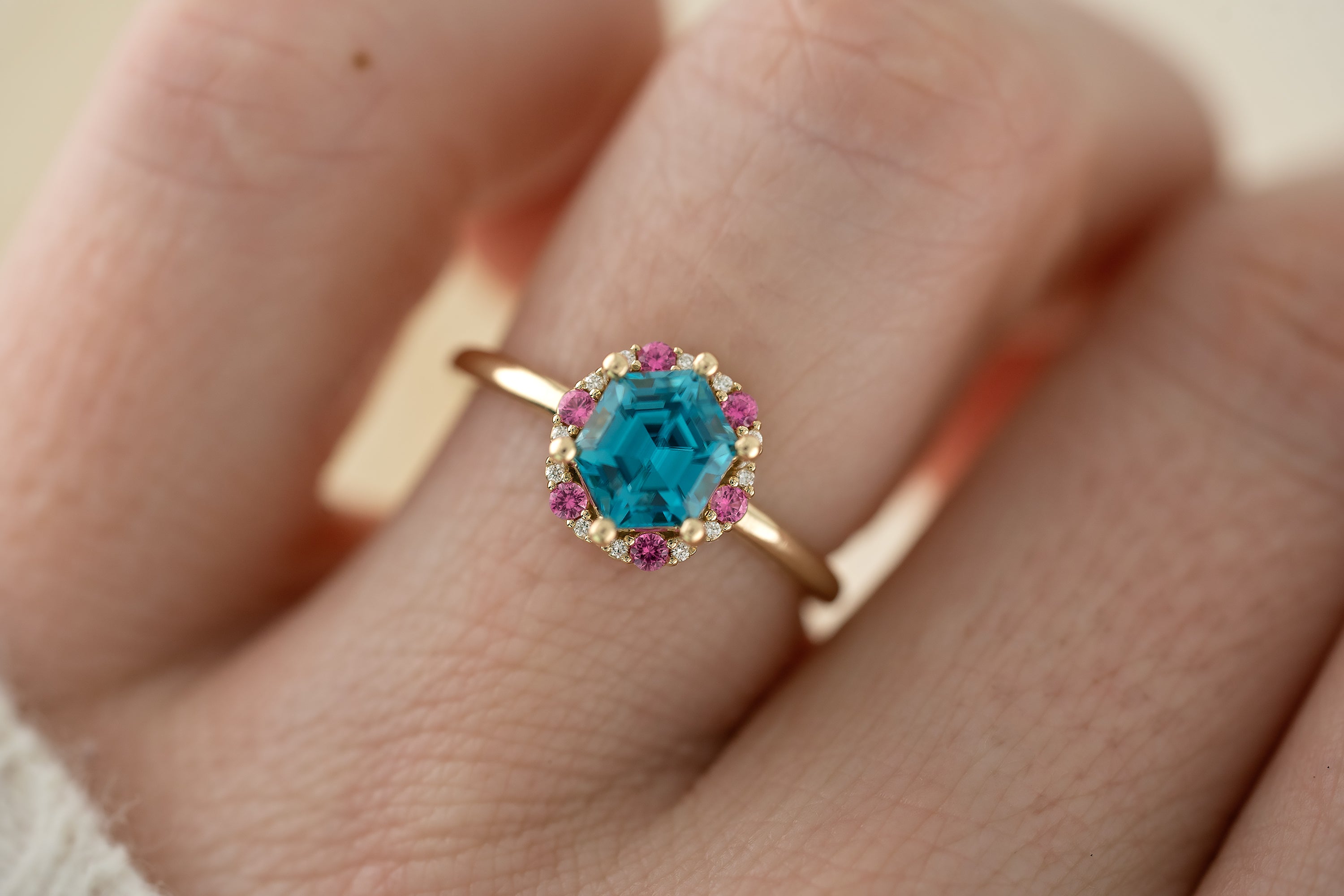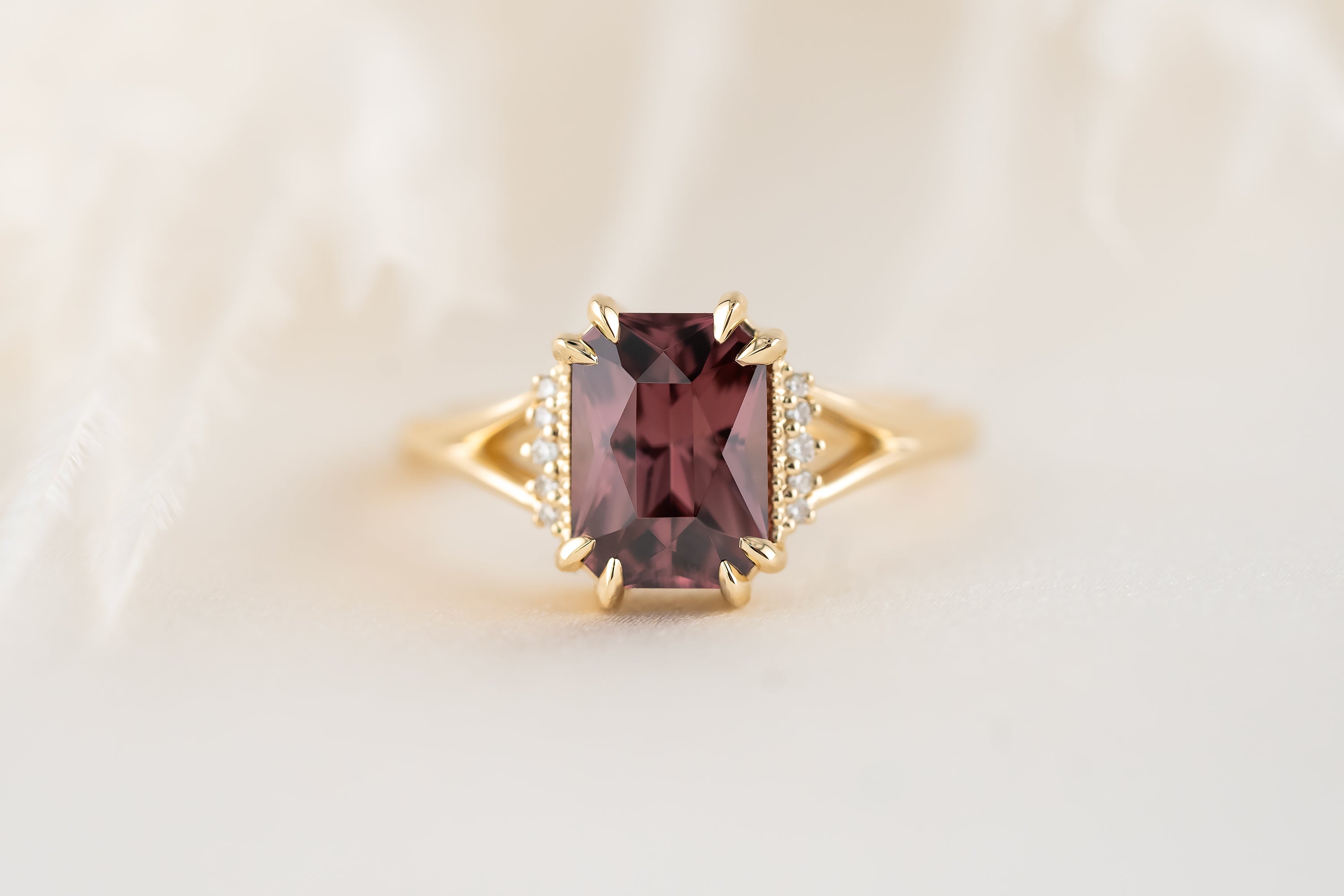The Tai Ring | Blue Zircon + Pink Sapphire
・ONE OF A KIND・
- Regular price
-
$2,000.00 - Regular price
-
- Sale price
-
$2,000.00
RING DETAILS
| Metal Type & Color | 14K Yellow Gold |
| Average Band Width | 1.7 mm |
CENTER STONE DETAILS
| Stone Type | Natural Zircon |
| Stone Shape | Hexagon Cut |
| Stone Carat Weight | 1.93 CT |
| Stone Dimensions | 7.9 x 6.2 mm |
ACCENT STONE DETAILS
| Stone Type | Natural Pink Sapphire, Natural Diamond |
This ring does not include a gemological report. Purchase your report here.
Ring Sizing Information
This ring is a standard US size 7 and can be resized within a two-size range while preserving its structural integrity, design, and overall quality. For example, a size 7 ring can be adjusted down to a 5 or up to a 9.
Please note: If you request resizing from our standard size 7, the processing time will be approximately 2–3 weeks before your order ships.
Couldn't load pickup availability
Shipping & Processing Information
Processing for all ready-to-ship items takes 1-2 business days before they are shipped.
We ship Mondays through Thursdays via UPS Overnight Air to prevent shipments from lingering in courier warehouses over the weekend.
Please be sure to check these processing times before placing your order, especially if you have a deadline. Keep in mind that delays can occur with mail couriers, so it's advisable to be prepared for any potential hiccups.
To read more about our shipping policies, please see our policy and FAQ page here.





About Natural Zircon
-

Hardness
Zircon has a hardness of 6 to 7.5 on the Mohs scale, offering good durability for jewelry when worn with care. While not as hard as sapphires or spinels, zircon’s beauty and brilliance make it a popular choice for special occasion pieces. With mindful wear, zircon can also be used in engagement rings, though extra attention is recommended to protect it from knocks and abrasions during daily activities.
- The Mohs scale is a measurement system used to assess and compare the hardness of minerals. Developed by Friedrich Mohs in 1812, it assigns a ranking from 1 to 10 to minerals based on their ability to scratch or be scratched by other minerals. This scale provides a simple and practical way to understand the relative hardness of different minerals, with 1 being the softest (e.g., talc) and 10 the hardest (e.g., diamond).
-

Color Range & Varieties
Blue Zircon:
The most popular and valuable zircon color, blue zircon typically ranges from bright sky blue to deep teal. Most blue zircons are heat-treated to enhance their vibrant color. Fine-quality blue zircons are highly prized for their brilliance and vivid saturation.Colorless (White) Zircon:
Renowned for its exceptional brilliance and fire, colorless zircon was once widely used as a natural diamond alternative. It offers a lively sparkle that rivals many gemstones.Golden and Yellow Zircon:
These stones display warm hues from soft yellow to rich golden tones. Naturally occurring, golden and yellow zircons bring a sunny, cheerful glow to jewelry designs.Brown Zircon:
Found in shades from champagne to deep chocolate, brown zircons offer an earthy, elegant look. While more common, well-cut brown zircons can still be striking and sophisticated.Green Zircon:
Natural green zircon is rare and ranges from muted yellow-green to grassy hues. Because of its scarcity, fine green zircon is highly valued by collectors.Pink, Rose, and Red Zircon:
These zircons can appear in soft blush pinks, warm rose tones, or deep reddish hues. Natural pink and red zircons are among the rarest and most sought-after zircon colors.Orange Zircon:
Vibrant orange zircons range from tangerine to burnt orange shades. Their bold, fiery color makes them a standout choice for unique and colorful jewelry pieces. -

Origin, Stability, & Treatments
Origin:
Zircon is found in a variety of locations around the world. Major sources include Sri Lanka, Cambodia, Myanmar (Burma), Vietnam, Australia, and Tanzania. Sri Lanka is known for producing a wide range of zircon colors, while Cambodia and Myanmar are especially famous for fine blue zircons.Stability:
Zircon is generally stable under normal wear, but care should still be taken.
High heat can cause color changes in zircon or even damage it.
Natural light exposure is typically safe, though some heated blue zircons may gradually fade if exposed to intense sunlight over long periods.
Like most gemstones, zircon should be protected from exposure to harsh chemicals and cleaning agents, which can damage its surface or alter its appearance.Due to its relative brittleness compared to harder gems like sapphire, zircon can be more susceptible to abrasions, chipping, or facet-edge wear with rough daily use. Settings that offer protection, like bezels or halo styles, are recommended for frequent wear.
Treatments:
Many zircons, particularly blue zircons, are heat-treated to enhance or change their color.
Heating brown or yellowish zircons at controlled temperatures can produce the vivid blues highly prized in the market. This treatment is considered permanent under normal conditions and is widely accepted in the gemstone trade.
Natural color zircons (such as some greens, yellows, and reds) also exist and may be available untreated, but they are rarer.We disclose all treatments on our stones.

















